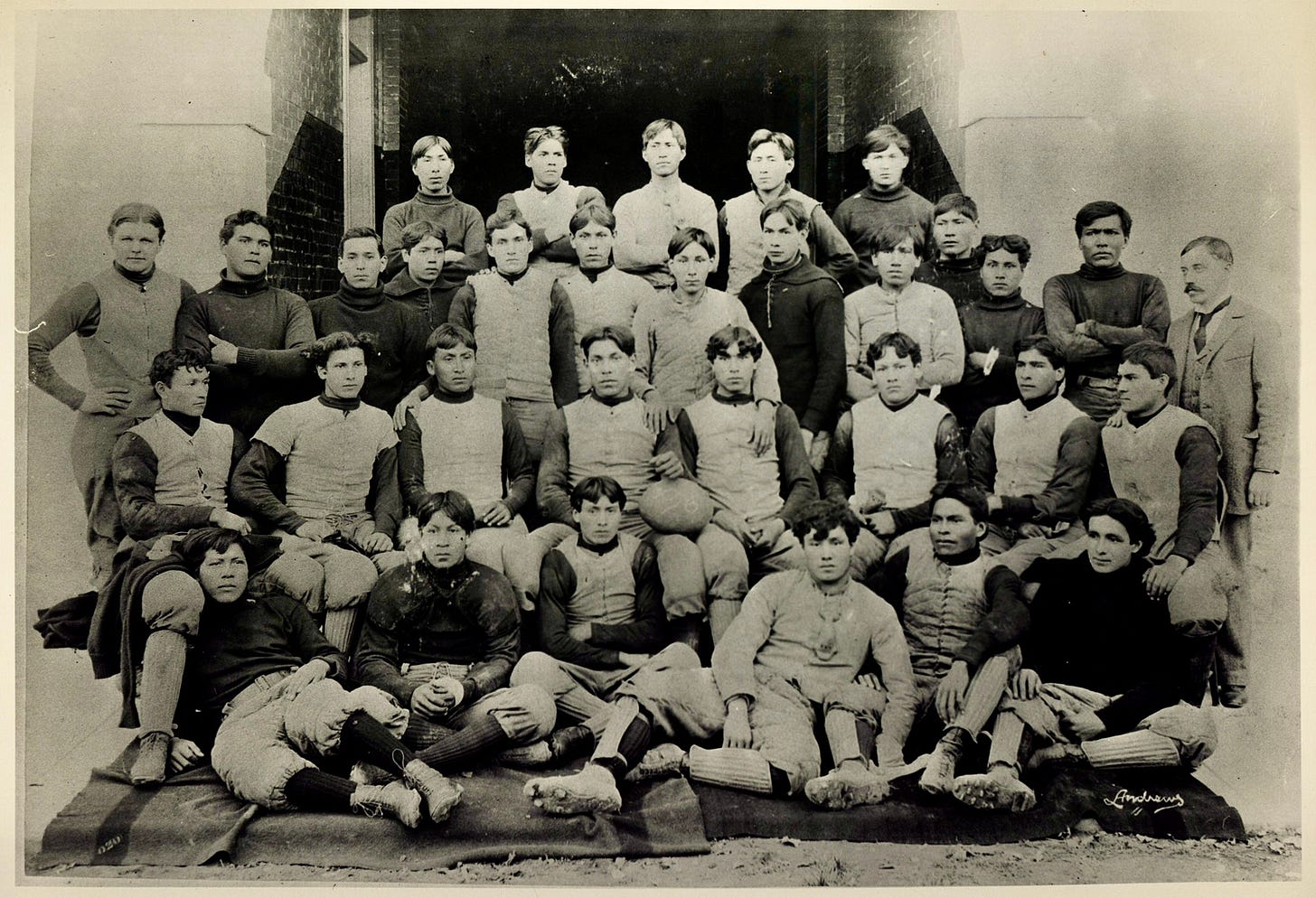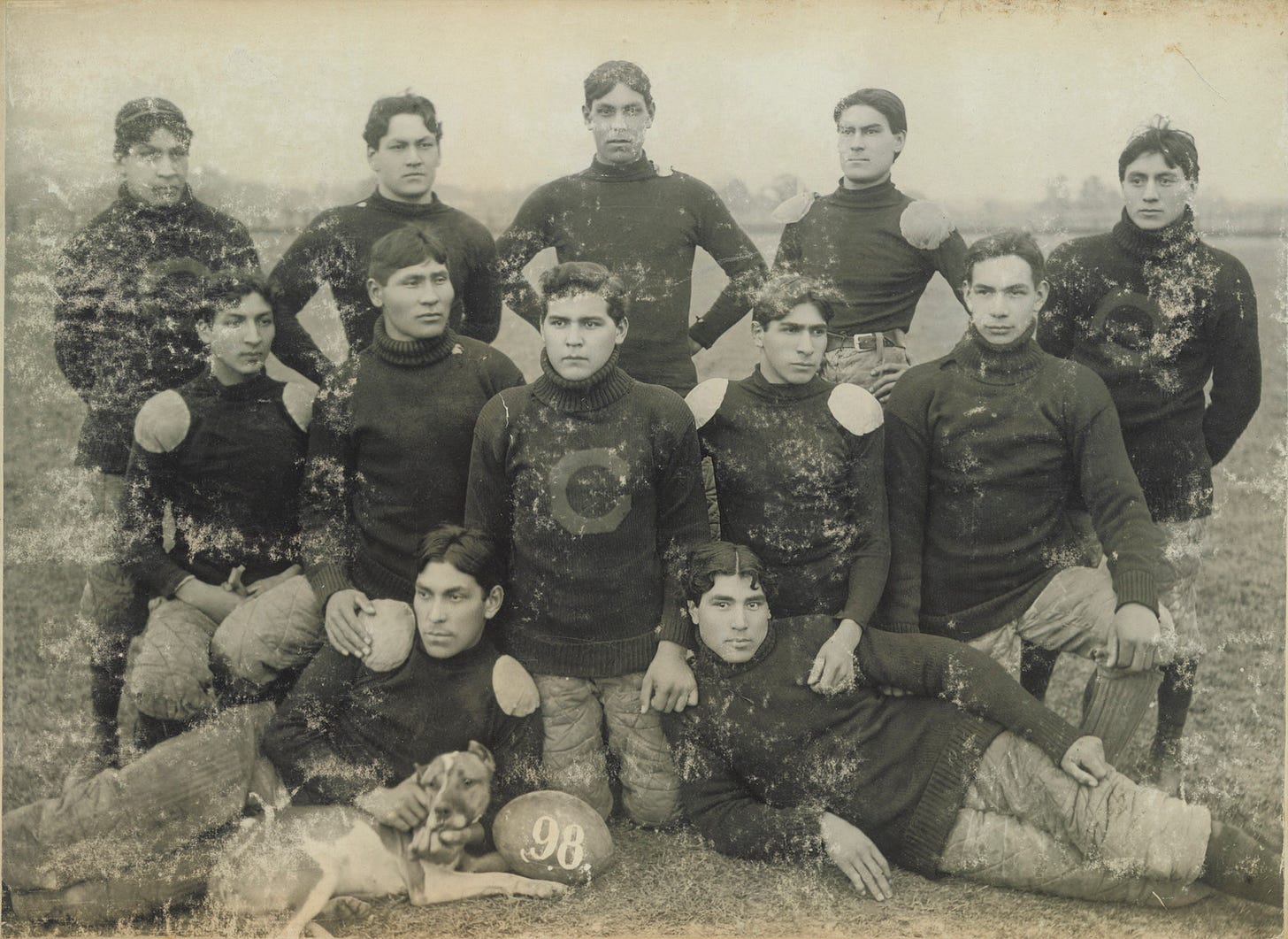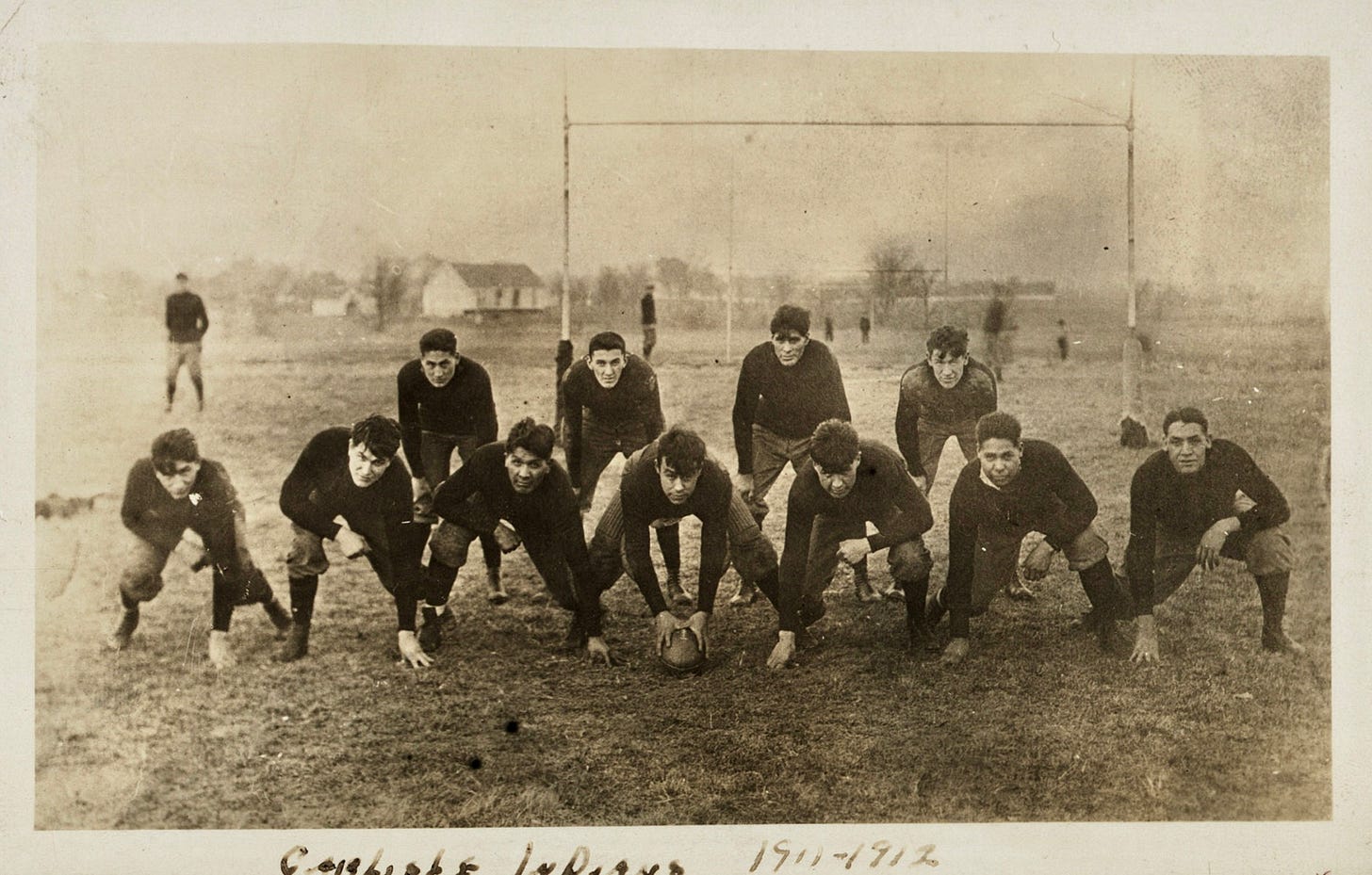Today's Tidbit... The Carlisle Globetrotters
College football remains a predominantly regional game despite the geographic barriers breaking down in recent years. The major conferences have geographic cores; with limited exceptions, teams at lower levels play in conferences covering one or a few bordering states. Travel time and costs have driven the game's geographical orientation since the beginning and continue to do so today.
Those teams that traveled outside their region in football's early days typically made one trip every few years, often playing more than one game on a trip or taking the trip over the Thanksgiving, Christmas, and New Year's holidays. Trains were slow compared to jets, so cross-country trips from east of the Mississippi to California generally took five to six days. Many top teams in or near major cities saw limited their travel for regular-season games because they could attract a bigger gate at home than when playing away. One example of such scheduling is Michigan regularly playing at Chicago in the 1890s and early 1900s.
The limited travel by most teams before the 1930s made the globetrotting habits of the Carlisle Indians all the more remarkable. They traveled at an unmatched pace, playing anybody anywhere, mainly because they earned purses far above anything they received at home in eastern Pennsylvania. So let's look at their travels outside the Northeast, which the U.S. Census defines as Connecticut, Maine, Massachusetts, New Hampshire, New Jersey, New York, Pennsylvania, Rhode Island, and Vermont. That definition does not include Maryland, Delaware, and Washington, D.C., each closer to Carlisle than some Northeastern states.
In the beginning, Carlisle had a light travel schedule. They fielded their first team in 1893, playing three local teams. The following two years, under former Yale All-American Vance McCormick, they played numerous top Eastern teams, stepping outside their home region to play at Navy.
1893 (2-1): Local games only
1894 (1-6-2): Navy
1895 (4-4): Navy
They were led in 1896 by Bill Hickock, another Yale All-American, who took the boys west with a contest at Cincinnati and an early indoor game against Wisconsin in the Chicago Coliseum.
1896 (5-5: Cincinnati, Wisconsin (Chicago)
A third Yalie, William Bull, took over in 1897 after leading Williams for six years. Bull's team won one more game than the year before and repeated their travel itinerary, though they played the Illini in the Chicago Coliseum rather than the Badgers.
1897 (6-4): Cincinnati, Illinois (Chicago)
Yet another Yale All-American, John Hall, led Carlisle in 1898. They also managed a 6-4 record, making another trip to Chicago to play Illinois.
1898 (6-4): Illinois (Chicago)
Traveling from eastern Pennsylvania to Chicago does not impress anyone these days. Still, such trips were unusual then, and Carlisle went much farther west at the end of the 1899 season, their first under Pop Warner. Carlisle lost only to Harvard and Princeton while beating Penn, Columbia, Cal, and their lesser opponents. The trip to play Cal made Carlisle the second college team to cross the Rockies for a football game. (Chicago did so in 1894.)
1899 (9-2): Cal, Phoenix Indians
They stayed closer to home for the next three years, managing trips to Virginia, Navy, Michigan, and Georgetown.
1900 (6-4-1): Virginia (DC), Maryland
1901 (5-7-1): Navy, Michigan (Detroit)
1902 (8-3): Virginia (Norfolk, VA), Georgetown (DC)
Carlisle went nuts in 1903, the last season of Warner's first tour there. Games at Georgetown and Virginia preceded a regular season game at Northwestern. A second trip to California saw them beat Utah, Reliance AC, and the Sherman Indian School.
1903 (11-2-1): Georgetown (DC), Virginia (Norfolk, VA) Northwestern, Utah, Reliance AC, Sherman

Eddie Rogers led Carlisle in 1904. He played four years at Carlisle and three at Minnesota before assuming command, taking them to games at Virginia, Ohio State, and a contest at the St. Louis World's Fair against the Haskell Indian School.
1904 (10-2): Virginia (Norfolk, VA), Ohio State, Haskell (St. Louis)
Former Yalie George Woodruff took the helm in 1905 after leading Penn for ten years and Illinois for one. They ventured only as far as Ohio, where they played three games.
1905 (10-4): Virginia (Richmond, VA), Massillon Tigers, Cincinnati, Canton AC, Georgetown
Bemus Pierce, another former Carlisle player, ran things in 1906. He took them west to Cincinnati and Minnesota and south to Vanderbilt and Virginia. To help his passers take advantage of the new forward pass, Pierce was the first coach to paint the helmets of his eligible receivers.
1906 (9-3): Cincinnati, Minnesota, Vanderbilt, Virginia (Norfolk, VA)
Pop Warner returned to Carlisle for the 1907 season to take on Minnesota and Chicago, losing only to Princeton. They went 10-2-1, tying Penn and losing to Harvard and Minnesota while beating St. Louis, Nebraska, and Denver on a trip west.
1907 (10-1): Minnesota, Chicago
1908 (10-2-1): Navy, Minnesota, St. Louis, Nebraska, Denver
Carlisle stayed closer to home for the next five years, which included the height of Jim Thorpe's career. Their only trip of note came in 1912 when they won at Georgetown on a Saturday, traveled to Toronto for a Monday game, and returned home to play Lehigh a few days later.
1909 (8-3-10): George Washington (DC), St. Louis
1910 (8-6): Virginia (DC), Navy, Johns Hopkins
1911 (11-1): Georgetown, Johns Hopkins
1912 (12-1-1): Georgetown, Toronto All-Stars
1913 (10-1-1): Georgetown, Johns Hopkins
Warner's last season gave Carlisle only its third losing season. Their wins came against lesser teams like Albright, Dickinson, and Alabama. A trip to Chicago and games in the Deep South with Bama and Auburn extended Carlisle's range.
1914 (5-10-1): Notre Dame (Chicago), Delaware, Alabama (Birmingham), Auburn (Atlanta)
Carlisle had a succession of one-year coaches from 1915 to 1917 when they deemphasized football. They played all their games in the region in 1915 and 1916 though things changed in 1917 when they traveled to West Virginia and Georgia Tech.
1915 (3-6-2): none
1916 (3-4-1): none
1917 (3-6): West Virginia, Navy, Johns Hopkins, Georgia Tech
Carlisle closed in 1918 when the federal government decided they had better things to do with Carlisle's facilities than run an Indian school. The school was converted into a hospital for soldiers returning from overseas. Carlisle's remaining students hit the road, transferring to similar schools elsewhere.
Besides their success on the field and producing one of the top players in the game's history, Carlisle pioneered regular intersectional scheduling. Chicago and Michigan traveled more than most schools, both making early trips to California, but neither approached Carlisle's level of travel to the West, Midwest, and South.
Football Archaeology is reader-supported. Click here to buy one of my books or otherwise support the site.




